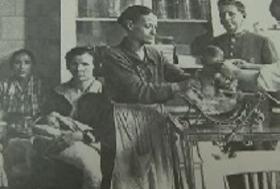
The well-baby clinic of Valencia was created in 1910 with the impetus of doctor Joaquín Aguilar Jordán, who, along with another important figure of Valencian medicine, the paediatrician professor Ramón Gómez Ferrer, actively participated in what we can consider one of the founding milestones of this specialty, the first Spanish Congress of Paediatrics held in Majorca in 1914.
Health, illness and childhood care in history reveals the strategic nature that health acquired in the contemporary industrial world. The growing medical-social interest for these ages of life is one of the features that define modernity, as indicated by Ellen Key in 1900 when designating the twentieth century as “the century of children”.
The high numbers of infant mortality in Spain in the late-nineteenth century and early twentieth century were not only a population drain and an economic problem, but also a moral concern. More and more attentive consideration (thanks, in part, to the development of bacteriological research and, later, to hygiene and social medicine) of infectious diseases as “preventable” meant a change of mentality based on determinist and fatalist assumptions (“little angels to heaven”, according to the popular phrase), on the adoption of active attitudes and the specific scientific responses, as Aguilar Jordán indicated in his work “On one of the most powerful causes of infant mortality in Valencia and the means to combat it”, appeared in the Revista Valenciana de Ciencias Médicas (‘Valencian Magazine of Medical Sciences’) in 1904.
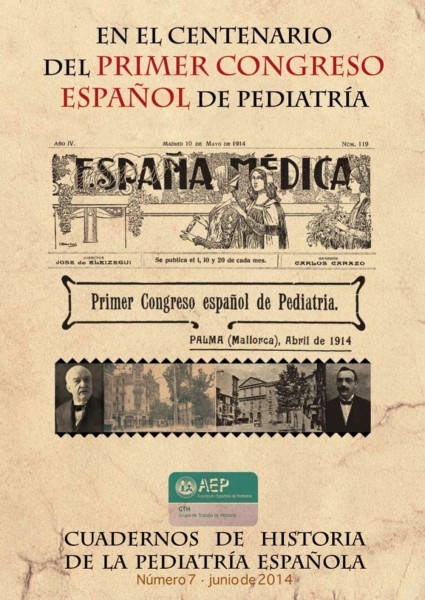
The protective legislative response, initiated in France with the Roussel Law (1874), was followed in other countries, as happened between us with the Children’s Protection Law, which was enacted on August 12, 1904. From the organisational point of view, a Higher Council for the Protection of Children was created, under which the provincial and local boards fell, whose responsibilities were to control nurseries and, in general, ensure compliance with the legislation on children and prepare statistical annual reports.
The medical and social responses to the problem of infant mortality had a double origin, public and private, and a reformist and philanthropic intention. The main resources to ensure the survival of infants from the most disadvantaged classes were the nursing and well-baby clinics, whose dating, in accordance with the criteria that would define them in all their functions, has been fixed, by consensus, in 1890. This purely local initiative was disseminated not only to the rest of France but soon it acquired such an important international dimension that it can only be explained by the context of concern for the life of the previously mentioned children, so that in the First International Congress of Well-baby Clinics (Paris, 1905) included more than one hundred organisations from France and fifty from abroad (with Spanish representatives). But, in addition, their flowering cannot be understood without taking into account the scientific and technical element, that is, the method for the sterilisation of milk, conceived by L. Pasteur, which raises the temperature of milk to 70º, keeps it like that for 40 minutes and then it quickly cools. In addition, with the adoption of the Gaertner method – mixing cow milk with a lactose and sodium chloride complex –, a final product was obtained that was more assimilable for infants than original cow milk.
In the Spanish case, the first well-baby clinic opened in 1902 in Barcelona. The precedents of the well-baby clinic have to be framed in the initiatives that took place at the infant clinics such important people as Francisco Vidal Solares, in Barcelona, or Joaquín Aguilar Jordán himself, in Valencia.
In addition, these new institutions were the workspace of childcare providers, specialists in paediatrics in social medicine. In Spain, with the indicated Barcelona antecedent, there were well-baby clinics and infant clinics since 1904, and almost all included a sterilisation and milk distribution service. There were almost forty of them from their inception, in 1902, until 1928. Their period of validity was variable. Some of them, as in the case of Alicante, closed the doors in 1940, others did so later and in some cases their life was ephemeral. In the Spanish case, the period of greatest relevance, spread and development of these institutions took place between 1904 and the civil war.
The Valencian case is especially interesting. It is often considered a precedent of the well-baby clinic (although it cannot actually be considered as such in terms of its goals and organisation) the former Lactation Asylum, founded in 1873 by King Amadeu de Saboya in a building located behind the Tobacco Factory, in the present Palace of Justice, in the gardens of the Glorieta. The purpose of this asylum was that the cigarettes had a place to breastfeed their children and that they could stay accommodated in adequate conditions. The care was provided by the nuns of the Franciscan order under the patronage of the City Council, which was partly responsible for the maintenance expenses. We know through the regulations ruling this activity, for example the one of 1925, that the mothers had a maximum of one hour per day to breastfeed, divided in two halves of thirty minutes each one, in the morning and in the afternoon.
The Tobacco Factory moved to a new building in the current street of Amadeu de Savoia, which was used by the Ateneu Mercantil de Valencia, by the impulse of its president, Tomas Trénor Palavicino, to promote the Exposition Regional Valenciana, which was inaugurated by King Alfonso XIII on May 22, 1909. In return, he undertook to build a new breastfeeding shelter in front of the building, behind the Municipal Palace of the Exhibition. His builder was the architect Ramón Lucini Calleja (1852-1939).
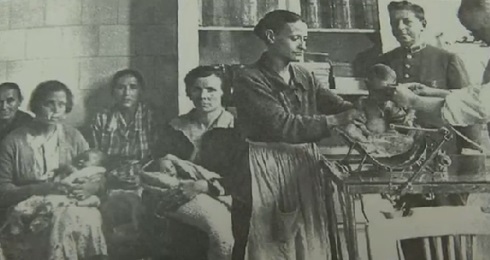
An inscription in the front of the building leaves proof of it: “The Ateneu Mercantil, vivid remainder of the Valencian Regional Exhibition, pioneered by its president, Mr. Tomás Trénor Palavicino, built it to serve as breastfeeding shelter and also for the infant children of the Tobacco Factory workers, that king Amadeo I of Savoy founded in 1873. Year 1909”.
The City Council launched this beneficial institution in 1910 in the former breastfeeding shelter. The cost of the material and the construction works amounted to 17,000 pesetas. The three sections, which were housed in three separate pavilions, were: the well-baby clinic in the strict sense, directed by Aguilar Jordán; the area for the examination of nursemaids on Mondays, Wednesdays and Fridays, at three in the afternoon, by Eladi Fajarnés, and, finally, a childhood polyclinic directed by Crespo, which opened on Tuesdays, Thursdays and Saturdays at the same time. The well-baby clinic provided, for ten cents a day, the entire amount of milk that the pediatrician considered to be the poorest mothers.
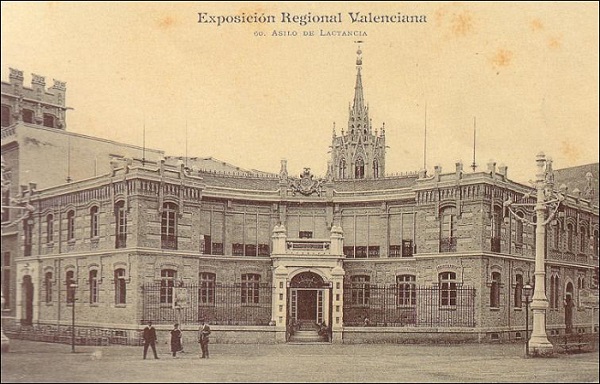
The institution’s objectives were to monitor the growth of children through the visit and periodic weighing of children under the age of two, the food supplement, if deemed necessary, health disclosure through direct advice (for example, indicated in the sources of the time that Dr. Aguilar Jordán delivered every Thursday conferences on childhood hygiene for mothers) and, as a fundamental element, the supply of sterilised milk. This free or very cheap milk supply was also a way of attracting the population most in need. Healthcare education, the pedagogical endeavour, was the guiding principle of these institutions, in which the figure of the doctor was essential, since the entry of paediatric nurses happened later on, in 1926 in the case of Spain. However, the provision of sterilised milk in bottles seemed to contradict the arguments in favour of paediatric breastfeeding, according to some historians. In fact, the number of written testimonies against artificial breastfeeding was very high, and these were the norm. For example, Aguilar Jordán himself, in a booklet addressed to the mothers of the Infants Hospital and Well-Baby Clinic of Valencia, said: “To nurture the children with blood, then with milk and, finally, with love and care, it is a real maternal trilogy, that is, it is to be three times mother”, therefore, it was necessary to use these institutions only in case of real need.
In any case, the birth of these institutions must be framed within the context of initiatives to promote breastfeeding and control mercenary breastfeeding. On this issue, in addition to the medical class, in some judicial instances, discussions were encouraged and the lack of control of mercenary breastfeeding could be criminalised. This is a good example of the blaming discourse of mothers, which was also omnipresent in the informative activities of the well-baby clinics, which highlighted the moral dimension of the duty of maternity, which included the condemnation of female work outside the home and established a certain consideration of the woman exclusively limited to the function of wife and mother.
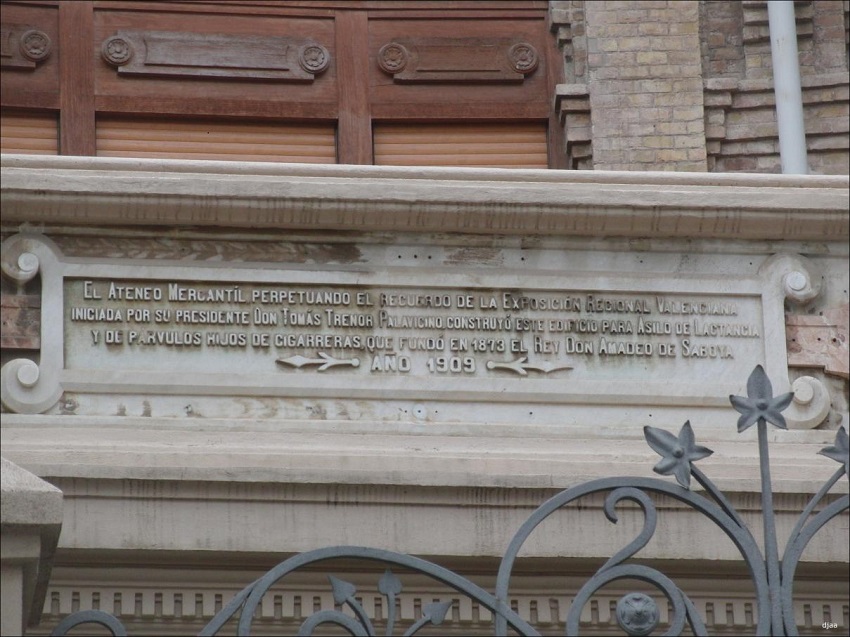
The breastfeeding shelter of Valencia, in the years of the second Republic became the Severino Chacón Nursery and Schools. After the civil war, it lost both the name and the schools and remained solely as a breastfeeding shelter.
In short, although there are important local and national studies on what these institutions meant, and despite the many problems that had to be faced and the implementation of an important tool in the fight against infant mortality and social inequalities in health, it is difficult to accurately assess its real influence on the rates of morbidity and mortality in these ages of life, since we need more data to reconstruct it in its entirety in Spain, and, in particular, in Valencia. It is necessary to have more field work on these entities in local contexts (we have studied, for example, in our environment, the well-baby clinics from Alicante), which allow us to have a global outlook, but, undoubtedly, both from the professional and specialised point of view and from the point of view of the growing adoption of clinical and laboratory concepts and techniques in the field of paediatrics and childcare, the provisional balance can be described as clearly positive.
The Maternal and Child Work derived from the forecast systems that were created from the beginning of the 20th century through the National Institute of Forecasting (INP), promoted the creation of a network of child health services that were absorbed by the Obligatory Insurance of Disease (OID), initiated in 1942, which was the precedent of the National Institute of Health (INSALUD). The care provided included child care, with the emergence of pediatric and childcare consultations by specialist doctors. In a different context, municipal (first-aid posts) and provincials (in charge of the provincial councils) benefitiaries, as well as other institutions rooted in the society for the care of children (well-baby clinics) almost lost most of their fundamental purpose.
Rosa Ballester (Miguel Hernández University)
To know more:
García Nieto, V. M. et al., “Historia y significación de las Gotas de Leche en España”, Cuadernos de Historia de la Pediatría Española, no. 8, 2014.
García Nieto, V. M. et al., “Algunas notas sobre la historia de la pediatría en Valencia”, Cuadernos de Historia de la Pediatría Española, no. 11, 2016.
Muñoz Pradas, F., “La implantación de las Gotas de Leche en España (1902- 1935). Un estudio a partir de la prensa històrica”, Asclepio, 2016; 68 (1).
Perdiguero-Gil, E. and Bernabeu Mestre, J., “La Gota de Leche de Alicante (1925-1940)”, in Benito Lloris À., Blay Meseguer, F. X., Lloret Pastor, J. (eds.), Beneficència i sanitat en els municipis valencians, Seminari d’Estudis sobre Ciència, Associació Cultural Alcoià-Comtat, Centre Alcoià d’Estudis Històrics i Arqueològics, Alcoy, 1999, pp. 291-310.
Personatges i espais de ciència (‘Science characters and spaces’) is a project of the Unit of Scientific Culture and Innovation of the University of Valencia, with the collaboration of the “López Piñero” Institute of History of Medicine and Science and with the support of the Spanish Foundation for Science and Technology and of the Ministry of Economy, Industry and Competitiveness.

















